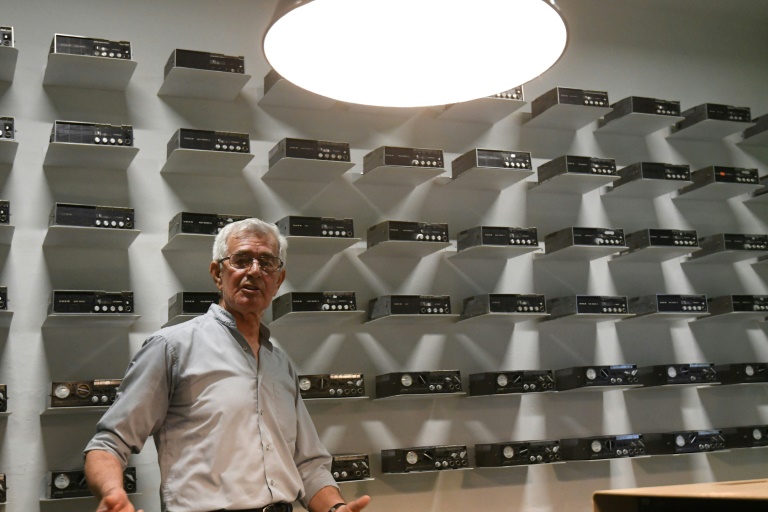24 hours in pictures, 29 April 2025
From his office in the shadowy "House of Leaves", Nesti Vako would listen to the private conversations of his fellow Albanians, spying for the state during the country's communist era.
“I had a table, a strong coffee and some equipment,” the 74-year-old said, as he escorted AFP around the feared former secret service headquarters in Tirana, which opened in May as a museum.
Named after the ivy that once crept up its walls, the House of Leaves shows the methods and tools of the all-pervading secret surveillance conducted under communist rule, which lasted for nearly half a century until the early 1990s.
“We put listening equipment in hotels, embassies, and so on… The microphones were placed under tables, under chairs, in picture frames, inside gas lamps,” said the tall, snowy-haired Vako, a former chief of surveillance.
Signs dedicate the museum to “those innocent victims who were spied on, arrested, prosecuted, convicted and executed” by a regime “that aimed at total control over human bodies and souls”.
One room displays dozens of recording devices — made in Albania and Germany, Japan and China — that were deployed to catch any whiff of criticism of the state or other banned activities, such as foreign travel and practising religion.
A laboratory remains where duplicate keys were forged for illegal searches and where foreign letters to the leadership of dictator Enver Hoxha were tested for biological weaponry.
Props on display that were used to hide spying kits, such as a long dark coat with a bulky inside zip pocket, would not look out of place on a James Bond parody film set.
But the consequences of this constant and invasive monitoring “remain an open wound” in the Balkan country of 2.9 million people, according to museum director Etleva Demollari.
– No justice –
“There was a lot of persecution in this era. Many people were condemned and suffered and for 25 years have not had justice,” she said.

Nesti Vako says he has no regrets over his work during Albania’s communist era as chief of surveillance
According to the Albanian association of former political prisoners, 5,577 men and 450 women were executed by the paranoid regime, while tens of thousands more were sent to prisons or camps for forced labour or internment.
The opening of the House of Leaves is seen as a step towards confronting that dark chapter of history, and follows the conversion of two of Tirana’s communist nuclear bunkers into museums in recent years.
None of the major sites where persecution took place have been turned into memorial sites for the victims.
But there are signs of that changing at Spac, once the country’s most notorious labour camp, which lies in a remote valley around 94 kilometres (58 miles) from Tirana.
Hundreds of “enemies of the state” are believed to have died in the camp’s dusty copper and pyrite mines, where they toiled for lengthy shifts fuelled by pitiful diets.
– ‘Dante’s Inferno’ –
In some of the galleries “the temperature rose to 40 degrees Celsius”, said former prisoner Saimir Maloku, as he revisited the crumbling prison buildings.
The 71 year-old spent six years at the camp and three at another jail, accused of being a British agent. In that time his weight nearly halved.
“I was a living corpse,” he said.
In the room where Maloku slept with dozens of other inmates, he pointed to marks on the walls where their narrow beds with straw-filled mattresses were stacked in three tiers.
Those deemed to underperform in the mines faced solitary confinement. Bids for freedom were thwarted by the harsh and steep terrain, which was lined with barbed wire fencing.
Spac was abandoned after communism fell, but Maloku has for years campaigned for the site to become a museum dedicated to its victims.
“I lived in Dante’s Inferno and thanked God I came out alive.”
– Prison preservation –
Albania’s House of Leaves museum includes a laboratory where letters to the leadership of dictator Enver Hoxha were tested for biological weaponry
In 2015, the New York-based World Monuments Fund put Spac on a list of 50 endangered heritage sites worldwide, criticising the prison’s “extremely advanced state of deterioration” and calling for it to be made a place of remembrance.
Emergency intervention work finally began in June to prevent further damage, funded by Sweden via the Albanian branch of Cultural Heritage without Borders (CHwB), a non-governmental organisation.
The group has been working since 2013 on what it calls the “memorialisation process” — holding inclusive discussions on the future of Spac, researching the labour camp and arranging visits.
The local “Spac Museum” NGO has also installed the first information panels around the complex.
The eventual goal is to turn it into a fully functional “site of memory” — although funding is still being secured and the timeline remains unclear, said Lejla Hadzic, head of CHwB in Albania.
She said the ongoing work at Spac was “a call for state institutions to fulfil their responsibility” in preserving the site.
Such efforts may help Albanians come to terms with a painful past, which Demollari said remained “very sensitive” and not discussed enough.
At the House of Leaves, as visitors wandered from room to room and absorbed the implications of his spying, Vako showed no remorse over his work for the regime.
“I’m very proud. Because what were we doing? We just checked information to see if anyone was conducting an unconstitutional activity.”
Download our app